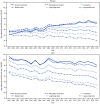Geographic Differences in Sex-Specific Chronic Obstructive Pulmonary Disease Mortality Rate Trends Among Adults Aged ≥25 Years - United States, 1999-2019
- PMID: 35511711
- PMCID: PMC9098243
- DOI: 10.15585/mmwr.mm7118a1
Geographic Differences in Sex-Specific Chronic Obstructive Pulmonary Disease Mortality Rate Trends Among Adults Aged ≥25 Years - United States, 1999-2019
Abstract
Chronic obstructive pulmonary disease (COPD) accounts for the majority of deaths from chronic lower respiratory diseases, the fourth leading cause of death in the United States in 2019.* COPD mortality rates are decreasing overall. Although rates in men remain higher than those in women, declines have occurred among men but not women (1). To examine the geographic variation in sex-specific trends in age-adjusted COPD mortality rates among adults aged ≥25 years, CDC analyzed 1999-2019 death certificate data, by urban-rural status,† U.S. Census Bureau region,§ and state. Among women, no significant change in overall COPD mortality occurred during this period; however, rates increased significantly in small metropolitan (average annual percent change [AAPC] = 0.6%), micropolitan (1.2%), and noncore (1.9%) areas and in the Midwest (0.6%). Rates decreased significantly in large central (-0.9%) and fringe metropolitan (-0.4%) areas (and in the Northeast (-0.5%) and West (-1.2%). Among men, rates decreased significantly overall (-1.3%), in all urban-rural areas (range = -1.9% [large central metropolitan] to -0.4% [noncore]) and in all regions (range = -2.0% [West] to -0.9% [Midwest]). Strategies to improve the prevention, treatment, and management of COPD are needed, especially to address geographic differences and improve the trend in women, to reduce COPD deaths.
Conflict of interest statement
All authors have completed and submitted the International Committee of Medical Journal Editors form for disclosure of potential conflicts of interest. No potential conflicts of interest were disclosed.
Figures


Similar articles
-
Potentially Excess Deaths from the Five Leading Causes of Death in Metropolitan and Nonmetropolitan Counties - United States, 2010-2017.MMWR Surveill Summ. 2019 Nov 8;68(10):1-11. doi: 10.15585/mmwr.ss6810a1. MMWR Surveill Summ. 2019. PMID: 31697657
-
Urban-Rural County and State Differences in Chronic Obstructive Pulmonary Disease - United States, 2015.MMWR Morb Mortal Wkly Rep. 2018 Feb 23;67(7):205-211. doi: 10.15585/mmwr.mm6707a1. MMWR Morb Mortal Wkly Rep. 2018. PMID: 29470455 Free PMC article.
-
Asthma Surveillance - United States, 2006-2018.MMWR Surveill Summ. 2021 Sep 17;70(5):1-32. doi: 10.15585/mmwr.ss7005a1. MMWR Surveill Summ. 2021. PMID: 34529643 Free PMC article.
-
Invasive Cancer Incidence, 2004-2013, and Deaths, 2006-2015, in Nonmetropolitan and Metropolitan Counties - United States.MMWR Surveill Summ. 2017 Jul 7;66(14):1-13. doi: 10.15585/mmwr.ss6614a1. MMWR Surveill Summ. 2017. PMID: 28683054 Free PMC article.
-
Rural and Urban Differences in Air Quality, 2008-2012, and Community Drinking Water Quality, 2010-2015 - United States.MMWR Surveill Summ. 2017 Jun 23;66(13):1-10. doi: 10.15585/mmwr.ss6613a1. MMWR Surveill Summ. 2017. PMID: 28640797 Free PMC article.
Cited by
-
Demographic and geographical trends in chronic lower respiratory diseases mortality in the United States, 1999 to 2020.Respir Res. 2024 Jun 24;25(1):258. doi: 10.1186/s12931-024-02880-5. Respir Res. 2024. PMID: 38915019 Free PMC article.
-
Pulmonary hypertension mortality trends in United States 1999-2019.Ann Epidemiol. 2022 Nov;75:47-52. doi: 10.1016/j.annepidem.2022.09.001. Epub 2022 Sep 9. Ann Epidemiol. 2022. PMID: 36089225 Free PMC article.
-
Epidemiological characteristics of chronic non-communicable diseases in Dongfang, China, 2021: a cross-sectional survey.BMJ Open. 2024 May 24;14(5):e081710. doi: 10.1136/bmjopen-2023-081710. BMJ Open. 2024. PMID: 38803260 Free PMC article.
-
Improving Patient-Centric COPD Management.Fed Pract. 2024 Nov;41(Suppl 6):S35-S40. doi: 10.12788/fp.0534. Epub 2024 Nov 20. Fed Pract. 2024. PMID: 39839063 Free PMC article. No abstract available.
-
Mortality Related to Chronic Obstructive Pulmonary Disease during the COVID-19 Pandemic: An Analysis of Multiple Causes of Death through Different Epidemic Waves in Veneto, Italy.Int J Environ Res Public Health. 2022 Oct 7;19(19):12844. doi: 10.3390/ijerph191912844. Int J Environ Res Public Health. 2022. PMID: 36232144 Free PMC article.
References
-
- CDC. The health consequences of smoking—50 years of progress: a report of the Surgeon General. Atlanta, GA: US Department of Health and Human Services, CDC; 2014. https://www.ncbi.nlm.nih.gov/books/NBK179276/pdf/Bookshelf_NBK179276.pdf
MeSH terms
LinkOut - more resources
Full Text Sources
Medical

